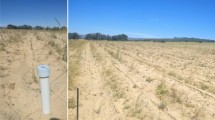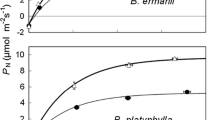Abstract
A study was carried out to test the effects of three rates of TSP (triple superphosphate) (0, 50, and 100 mg·kg−1 P) on growth of broom with and without radiata pine seedlings and to determine the relationships between P concentrations in the broom shoot and dry matter yields with soil plant-available P (Bray-2 P). A bulk sample of soil was collected from Kaweka forest at soil depth of 0–10 cm, in New Zealand on March 11, 2001. The forest area was not supplied with fertiliser at least 30 years. The results show that TSP application increased P availability in the soil. The P availability concentration in soil of broom with radiata pine seedlings was higher than that in soil of broom alone. Bray-2 P concentrations had a significant logarithmic relationship with P concentrations of broom shoot and an exponential relationship with dry matter weight of whole broom plant.
Similar content being viewed by others
References
Binkley D, Giardina C, Bashkin MA. 2000. Soil phosphorus pools and supply under the influence of Eucalyptus saligna and nitrogen-fixing Albizia falcataria. Forest Ecology and Management, 128: 241–247.
Binkley D, Senock R, Cromack JrK. 2003. Phosphorus limitation on nitrogen fixation by Facaltaria seedlings. Forest Ecology and Management, 186: 171–176.
Blakemore LC, Searle PL, Day BK. 1987. Methods for chemical analysis of soils. Lower Hutt, New Zealand: New Zealand Soil Bureau, Scientific Report, NZ Soil Bureau, p. 80.
Chen CR, Condron LM, Davis MR, Sherlock RR. 2000. Effects of afforestation on phosphorus dynamics and biological properties in a New Zealand grassland soil. Plant and Soil, 220: 151–163.
Chen CR, Condron LM, Sinaj S, Davis MR, Sherlock RR, Frossard E. 2003. Effects of plant species on phosphorus availability in a range of grassland soils. Plant and Soil, 256: 115–130.
Clark CJ, McBride MB. 1984. Cation and anion retention by natural and synthetic allophane and imogolite. Clays and Minerals, 22: 291–299.
Clinton PW, Frampton CM, Mead DJ. 1994. Modelling competitive pasture effects on nutrient uptake by Pinus radiata. New Zealand Journal of Forestry Science, 24: 268–278.
Condron LM, Davis MR, Newman RH, Cornforth S. 1996. Influence of conifers on the forms of phosphorus in selected New Zealand grassland soils. Biology and Fertility of Soils, 21: 37–42.
Davis MR. 1995. Influence of radiata pine seedlings on chemical properties of some New Zealand montane grassland soils. Plant and Soil, 176: 255–262.
Davis MR, Lang MH. 1991. Increased nutrient availability in topsoils under conifers in the South Island high country. New Zealand Journal of Forestry Science, 21: 165–179.
DeLucia EH, Callaway RM, Thomas EM, Schlesinger WH. 1997. Mechanisms of phosphorus acquisition for ponderosa pine seedlings under high CO2 and temperature. Annals Botany, 79: 111–120.
Fogarty G, Facelli JM. 1999. Growth and competition of Cytisus scoparius, an invasive shrub, and Australian native shrubs. Plant Ecology, 144: 27–35.
Fox TR, Comerford NB. 1992. Influence of oxalate loading on phosphorus and aluminum solubility in Spodosols. Soil Science Society of America Journal, 56: 290–94.
Gadgil RL, Charlton JFL, Sandberg AM, Allen PJ. 1992. Nutritional relationships between pampas grass (Cortaderia spp.) and Pinus radiata. New Zealand Journal of Forestry Science, 22: 3–11.
Giddens KM, Parfitt RL, Percival HJ. 1997. Comparison of some soil properties under Pinus radiata and improved pasture. New Zealand Journal of Agricultural Research, 40: 409–416.
Hewitt AE. 1998. New Zealand soil classification. Landcare research science series No. 1. Lincoln, New Zealand: Manaaki Whenua Press, Landcare Research New Zealand Ltd., p. 133.
Hunter IR, Hunter JAC. 1991a. Apparent phosphorus uptake and change in nitrogen content of Pinus radiata growing on soils of different phosphorus retention, treated with superphosphate and A-grade rock phosphate. New Zealand Journal of Forest Science, 21: 50–61.
Hunter IR, Rodgers BE, Dunningham A, Prince JM, Thorn AJ. 1991b. An atlas of radiata pine nutrition in New Zealand. Rotorua, New Zealand: New Zealand Ministry of Forestry. FRI Bulletin No. 165, 24 pp.
Leco Corporation. 1996. CNS-2000 Elemental Analyzer — Instruction Manual. St. Joseph (MI): LECO Corporation, p. 25.
Liu Q, Loganathan P, Hedley MJ, Skinner MF. 2004. The mobilisation and fate of soil and rock phosphate in the rhizosphere of ectomycorrhizal Pinus radiata seedlings in an Allophanic Soil. Plant and Soil, 264: 219–229.
MacLaren JP. 1993. Radiata Pine Growers’ Manual. New Zealand: New Zealand Forest Research Institute, Rotorua. FRI Bulletin No.184.
Mason EG, Milne PG. 1999. Effects of weed control, fertilization, and soil cultivation on the growth of Pinus radiata at midrotation in Canterbury, New Zealand. Canadian Journal of Forest Research, 29: 985–992.
Mehlich A. 1978. Influence of fluoride, sulfate and acidity on extractable phosphorus, calcium, magnesium and potassium. Communication in Soil Science and Plant Analysis, 9: 455–476.
Middleton KR, Toxopeus MRJ. 1973. Diagnosis and measurement of multiple soil deficiencies by a substractive technique. Plant and Soil, 38: 219–226.
Nielsen ET, Karpa, D, Mooney HA, Field C. 1993. Patterns of stem photosynthesis in two invasive legumes (Spartium junceum, Cytisus scoparius) of the California coastal region. American Journal of Botany, 80: 1126–1136.
O’Connell AM, Grove TS. 1996. Biomass production, nutrient uptake and nutrient cycling in the Jarrah (Eucalyptus marginate) and Karri (Eucalyptus diversicolor) forests of South-western Australia. In: PM Attiwill and MA Adams (eds), Nutrition of Eucalyptus. Victoria, Australia: CSIRO Australia, pp. 155–190.
Parfitt RL. 1989. Phosphate reactions with natural allophane, ferrihydrite and goethite. Journal of Soil Science, 40: 359–369.
Parker IM. 2000. Invasion dynamics of Cytisus scoparius: a matrix model approach. Ecological Applications, 10: 726–743.
Partridge TR. 1992. Successional interactions between bracken and broom on the Port Hills, Canterbury, New Zealand. Journal of Applied Ecology, 29: 85–91.
Paynter Q, Downey PO, Sheppard AW. 2003. Age structure and growth of the woody legume weed Cytisus scoparius in native and exotic habitats: implications for control. Journal of Applied Ecology, 40: 470–480.
Peterson DJ, Prasad R. 1998. The biology of Canadian weeds. 109. Cytisus scoparius (L.) Link. Canadian Journal of Plant Science, 78: 497–504.
Richardson B, Vanner A, Ray J, Davenhill N, Coker G. 1996. Mechanisms of Pinus radiata growth suppression by some common forest weed species. New Zealand Journal of Forestry Science, 26(3): 421–437.
Rivaie AA, Loganathan P, Graham JD, Tillman RW, Payn TW. 2008. Effect of phosphate rock and triple superphosphate on soil phosphorus fractions and their plant-availability and downward movement in two volcanic ash soils under Pinus radiata plantations in New Zealand. Nutrient Cycling in Agroecosystems, 82: 75–88.
Roy B, Popay I, Champion P, James T, Rahman A. 1998. An illustrated guide to common weeds of New Zealand. Canterbury, Rotorua, New Zealand: New Zealand Plant Protection Society (Inc), p.314.
SAS. 2001. Instruction Manual. North Carolina, USA: SAS Institute Inc., Cary, North Carolina, USA. p. 335.
Scott JT. 2002. Soil Phosphorus Dynamics in a Temperate Silvopastoral System. PhD Thesis. Lincoln University, Lincoln: New Zealand, p. 294.
Searle PL. 1975. Automated colorimetric determination of ammonium ions in soil extracts with ‘Technicon Autoanalyser II equipment’. New Zealand Journal of Agricultural Research, 18: 183–187.
Shaben J, Myers JH. 2010. Relationships between Scotch broom (Cytisus scoparius), soil nutrients, and plant diversity in the Garry oak savannah ecosystem. Plant Ecology, 207(1): 81–91.
Soil Survey Staff. 1999. Soil Taxonomy. A basic system of soil classification for making and interpreting soil surveys (2nd edition). Washington DC, USA: Agricultural Handbook 436, Natural Resources Conservation Service, USDA, p. 869.
Steel RGD, Torrie JH, Dickey DA. 1997. Analysis of Variance IV. Split-plot Design and Analysis. In: Principle and Procedures of Statistics: a Biometrical Approach, (3rd edition). New York, USA: The McGraw-Hill Companies, Inc., p. 672.
Tabard P. 1985. Une plante energetique a cycle court. Le genet: Cytisus scoparius. In: Energy from biomass. (Eds. W Palz, J Coombs, DO Hall). London, England: Applied Science, London, pp. 283–291.
Twine JR, Williams CH. 1971. The determination of phosphorus in kjeldahl digests of plant materials by automatic analysis. Communication in Soil Science and Plant Analysis, 2: 485–489.
Watt MS, Whitehead D, Richardson B, Mason EG, Leckie AC. 2003a. Modelling the influence of weed competition on the growth of for light and water on growth of young Pinus radiata at a dryland site. Forest Ecology and Management, 178: 271–286.
Watt MS, Whitehead D, Mason EG, Richardson B, Kimberley MO. 2003b. The influence of weed competition for light and water on growth and dry matter partitioning of young Pinus radiata, at a dryland site. Forest Ecology and Management, 183: 363–376.
Watt MS, Clinton PW, Whitehead D, Richardson B, Mason EG, Leckie AC. 2003c. Above-ground biomass accumulation and nitrogen fixation of broom (Cytisus scoparius L.) growing with juvenile Pinus radiata on a dryland site. Forest Ecology and Management, 184: 93–104.
Williams PA. 1981. Aspects of the ecology of broom (Cytisus scoparius) in Canterbury, New Zealand. New Zealand Journal of Botany, 19: 31–43.
Zou X, Binkley D, Caldwell BA. 1995. Effects of dinitrogen-fixing trees on phosphorus biogeochemical cycling in contrasting forests. Soil Science of American Journal, 59: 1452–1458.
Author information
Authors and Affiliations
Corresponding author
Additional information
Foundation project: The study is financially supported by the Centre for Sustainable Forest Management at Forest Research Institute (FRI), Rotorua, New Zealand
The online version is available at http://www.springerlink.com
Rights and permissions
About this article
Cite this article
Rivaie, A.A. Growth response of broom (Cytisus scoparius) growing with and without radiata pine (Pinus radiata) seedlings to different P levels in soils. Journal of Forestry Research 22, 597–602 (2011). https://doi.org/10.1007/s11676-011-0173-9
Received:
Accepted:
Published:
Issue Date:
DOI: https://doi.org/10.1007/s11676-011-0173-9




